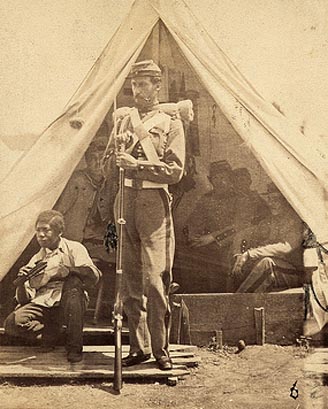The Smithsonian American Art Museum is organizing a major exhibition that examines how America’s artists represented the impact of the Civil War and its aftermath. Winslow Homer, Eastman Johnson, Frederic Church
and


Sanford Gifford—four of America’s finest artists of the era—anchor the exhibition.
“The Civil War and American Art” follows will be on view at the museum’s main building in Washington, D.C., from Nov. 16, 2012, through April 28, 2013. Eleanor Jones Harvey, chief curator, is organizing the exhibition. The Metropolitan Museum of Art in New York City is the only other venue for the exhibition.

“The 150th anniversary of the American Civil War provides an important opportunity to explore the ways that the visual arts served as a cultural barometer of the mood of the nation during this great internal conflict,” said Elizabeth Broun, The Margaret and Terry Stent Director of the Smithsonian American Art Museum. “We believe the exhibition will attract a national audience that wants to understand the powerful emotional effect the events of the 1860s had on American culture.”

“The Civil War and American Art” follows the conflict from palpable unease on the eve of war, to heady optimism that it would be over with a single battle, to the growing realization that this conflict would not end quickly, to grappling with issues surrounding emancipation and the need for reconciliation. Genre and landscape painting captured the transformative impact of the war, not traditional history painting.
“This exhibition will show how American artists responded in the moment to a great national crisis and how it changed our ambition for America’s civilization, reinventing the Founders’ ideals for a new age,” said Harvey. “The landscapes and genre paintings in the exhibition gave voice to our highest concerns and deepest ideals during the war that has been called the ‘second American Revolution.’”
The exhibition included approximately 60 paintings as well as vintage photographs. The artworks were chosen for their aesthetic power in conveying the intense emotions of the period. Homer and Johnson grappled directly with issues such as emancipation and reconciliation. Church and Gifford contended with the destruction of the idea that America was a “New Eden.” Most of the artworks in the exhibition were made during the war, when it was unclear how long it might lastand which side would win. The exhibition also includes battlefield photography, which carried the gruesome burden of documenting the carnage and destruction.
Church disclosed both his patriotism and his piety by including brilliant sunsets, auroras, and rainbows overarching the terrain in major works such as

Aurora Borealis (1865; Smithsonian American Art Museum)

and Rainy Season in the Tropics (1866; Museum of Fine Arts, San Francisco), a pair of pictures that he conceived on the eve of the Union victory in the Civil War.
The visceral and immediate impact of these images by Mathew Brady, Alexander Gardner, Timothy H. O’Sullivan and George Barnard freed the fine arts to explore the deeper significance of the Civil War, rather than chronicle each battle.

Timothy H. O’Sullivan’s “Incidents of the War: A Harvest of Death” Smithsonian American Art Museum
Timothy H. O’Sullivan was one of many photographers that Mathew Brady, the so-called father of photojournalism, dispatched to document the troops during the Civil War. “These photographers had a dual duty,” says chief curator Eleanor Harvey. “They were to document the war and what it was really like, and they were to do it at the highest level, often adjusting bodies to get a well-composed picture.” O’Sullivan’s A Harvest of Death, which captured Confederate casualties at Gettysburg in 1863, is part of the museum’s collection and will be exhibited in “The Civil War and American Art,” opening November 16, 2012. “With the gruesomeness of the foreground, the figure on horseback in the background becomes like a grim reaper overseeing his harvest of death,” says Harvey.
A robust series of public programs and online features will accompany the exhibition’s presentation; details will be available on the museum’s website in 2012.
Publication

The book that will accompany the exhibition is a major scholarly catalog authored by Harvey, which will focus on the coming of age of American art during the Civil War.
Tour
After closing in Washington, D.C., the exhibition will travel to The Metropolitan Museum of Art in New York City (May 21, 2013–Sept. 2, 2013).
About the Smithsonian American Art Museum
The Smithsonian American Art Museum celebrates the vision and creativity of Americans with artworks in all media spanning more than three centuries. Its National Historic Landmark building is located at Eighth and F streets N.W., above the Gallery Place/Chinatown Metrorail station. Museum hours are 11:30 a.m. to 7 p.m. daily, except Dec. 25. Admission is free. Follow the museum on Twitter, Facebook, Flickr, iTunes, ArtBabble, Vimeo and YouTube. Museum information (recorded): (202) 633-7970. Smithsonian Information: (202) 633-1000; (202) 633-5285 (TTY).